Influence of Different Proportion Intercropping on Oat and Common Vetch Yields and Nutritional Composition at Different Growth Stages
Abstract
1. Introduction
2. Materials and Methods
2.1. Experimental Site
2.2. Experimental Design
2.3. Sampling and Measurements
2.4. Nutrition Quality Analysis
2.5. Statistical Analyses
3. Results
3.1. Green Grass Yield
3.2. Dry Matter Biomass
3.3. Crude Protein Content
3.4. Crude Protein Yield
3.5. Crude Fat Content
3.6. Crude Fat Yield
3.7. Neutral and Acid Detergent Fiber
3.8. Correlation Analysis
4. Discussion
5. Conclusions
Author Contributions
Funding
Institutional Review Board Statement
Acknowledgments
Conflicts of Interest
References
- Ren, J.Z.; Hu, Z.Z.; Zhao, J.; Zhang, D.G.; Hou, F.J.; Lin, H.L.; Mu, X.D. A grassland classification system and its application in China. Rangel. J. 2008, 30, 199–209. [Google Scholar] [CrossRef]
- Shen, H.; Zhu, Y.; Zhao, X.; Geng, X.; Gao, S.; Fang, J. Analysis of current grassland resources in China. Chin. Sci. Bull. 2016, 61, 139–154. [Google Scholar]
- Herrero, M.; Gerber, P.; Vellinga, T. Livestock and greenhouse gas emissions: The importance of getting the numbers right. Anim. Feed Sci. Technol. 2011, 166–167, 779–782. [Google Scholar] [CrossRef]
- Shan, L.C.; De Brún, A.; Henchion, M.; Li, C.; Murrin, C.; Wall, P.G.; Monahan, F.J. Consumer evaluations of processed meat products reformulated to be healthier—A conjoint analysis study. Meat Sci. 2017, 131, 82–89. [Google Scholar] [CrossRef]
- Wang, M.L. A new way to effectively solve the problem of food security: Focus on the development of forage industry. China’s Rural Econ. 2015, 12, 63–74. [Google Scholar]
- Ai, P.R.; Ma, Y.J.; Ma, L. Study on evaporation variation of jujube trees under drip irrigation of jujube and cotton intercropping in an arid area. Acta Ecol. Sin. 2018, 38, 4761–4769. [Google Scholar]
- Li, Q.-S.; Wu, L.-K.; Chen, J.; Khan, M.A.; Luo, X.-M.; Lin, W.-X. Biochemical and microbial properties of rhizospheres under maize/peanut intercropping. J. Integr. Agric. 2016, 15, 101–110. [Google Scholar] [CrossRef]
- Zhang, X.H.; Ding, H.; Zhou, Z.X. Effects of wheat/alfalfa intercropping on soil nutrients. Sch. J. Agric. Vet. Sci. 2016, 3, 346–350. [Google Scholar]
- Xu, B.C.; Li, F.M.; Shan, L. Switchgrass and milkvetch intercropping under 2:1 row-replacement in semiarid region, northwest China: Aboveground biomass and water use efficiency. Eur. J. Agron. 2008, 28, 485–492. [Google Scholar] [CrossRef]
- Zhang, W.; Ahanbieke, P.; Wang, B.J. Temporal and spatial distribution of roots as affected by interspecific interactions in a young walnut/wheat alley cropping system in northwest China. Agrofor. Syst. 2015, 89, 327–343. [Google Scholar] [CrossRef]
- Wang, Z.; Wu, P.; Zhao, X. Water use and crop coefficient of the wheat–maize strip intercropping system for an arid region in northwestern China. Agric. Water Manag. 2015, 161, 77–85. [Google Scholar] [CrossRef]
- Mei, P.P.; Gui, L.G.; Wang, P. Maize/faba bean intercropping with rhizobia inoculation enhances productivity and recovery of fertilizer P in a reclaimed desert soil. Field Crops Res. 2012, 130, 19–27. [Google Scholar] [CrossRef]
- Gao, Y.; Wu, P.; Zhao, X. Growth, yield, and nitrogen use in the wheat/maize intercropping system in an arid region of northwestern China. Field Crops Res. 2014, 167, 19–30. [Google Scholar] [CrossRef]
- Wang, Q.; Sun, D.; Hao, H. Photosynthetically active radiation determining yields for an intercrop of maize with cabbage. Eur. J. Agron. 2015, 69, 32–40. [Google Scholar] [CrossRef]
- Chen, Z.; Cui, H.; Wu, P. Study on the optimal intercropping width to control wind erosion in North China. Soil Tillage Res. 2010, 110, 230–235. [Google Scholar] [CrossRef]
- Gronle, A.; Lux, G.; Boehm, H. Effect of ploughing depth and mechanical soil loading on soil physical properties, weed infestation, yield performance and grain quality in sole and intercrops of pea and oat in organic farming. Soil Tillage Res. 2015, 148, 59–73. [Google Scholar] [CrossRef]
- Liang, K.; Yang, T.; Zhang, S. Effects of intercropping rice and water spinach on net yields and pest control: An experiment in southern China. Int. J. Agric. Sustain. 2016, 14, 448–465. [Google Scholar] [CrossRef]
- Yan, W.K. Singular-value partitioning in biplot analysis of multienvironment trial data. Agron. J. 2002, 94, 990–996. [Google Scholar]
- Sohail, S.; Ansar, M.; Skalicky, M. Influence of Tillage Systems and Cereals–Legume Mixture on Fodder Yield, Quality and Net Returns under Rainfed Conditions. Sustainability 2021, 13, 2172. [Google Scholar] [CrossRef]
- Zhang, Z.; Duan, J.; Wang, S. Effects of seeding ratios and nitrogen fertilizer on ecosystem respiration of common vetch and oat on the Tibetan plateau. Plant Soil 2012, 362, 287–299. [Google Scholar] [CrossRef]
- Mut, Z.; Akay, H. Effect of seed and drought stress on germination and seedling growth of naked oat (Avena sativa L.). Bulg. J. Agric. Sci. 2010, 16, 459–467. [Google Scholar]
- Tenopala, J.; Barrera, F.J. Physiological responses of the green manure, Vicia sativa, to drought. Bot. Sci. 2012, 9, 305–311. [Google Scholar] [CrossRef][Green Version]
- Mao, Z.X.; Hua, F.U.; Niu, D.C. The optimal cutting date of common vetch forage Lanjian No. 1 in Xiahe region, Gansu. Pratacultural Sci. 2015, 32, 1653–1659. [Google Scholar]
- Li, J.K.; Sun, T.; Wang, Z. Effects on Mixture Sowing Ratio on the Yield and Quality of both Vetch and Oat in Tibet. Acta Agrestia Sin. 2011, 19, 830–833. [Google Scholar]
- Wang, X.; Duan, Y.; Zhang, J.; Ciampitti, I.A.; Cui, J.; Qiu, S.; He, P. Response of potato yield, soil chemical and microbial properties to different rotation sequences of green manure-potato cropping in North China. Soil Tillage Res. 2022, 217, 105273. [Google Scholar] [CrossRef]
- Horwitz, W.; George, W. Latimer. Official methods of analysis of AOAC International 18th Edition. Assoc. Off. Anal. Chem. 2007, 16. [Google Scholar]
- Van Soest, P.J.; Robertson, J.B.; Lewis, B.A. Methods for dietary fiber, neutral detergent fiber, and nonstarch polysaccharides in relation to animal nutrition. J. Dairy Sci. 1991, 74, 3583–3597. [Google Scholar] [CrossRef]
- Molla, E.A.; Wondimagegn, B.A.; Chekol, Y.M. Evaluation of biomass yield and nutritional quality of oats–vetch mixtures at different harvesting stage under residual moisture in Fogera District, Ethiopia. Agric. Food Secur. 2018, 7, 88. [Google Scholar] [CrossRef]
- Sun, T.; Li, Z.; Wu, Q. Effects of alfalfa intercropping on crop yield, water use efficiency, and overall economic benefit in the Corn Belt of Northeast China. Field Crops Res. 2018, 216, 109–119. [Google Scholar] [CrossRef]
- Li, X.; Mu, Y.; Cheng, Y. Effects of intercropping sugarcane and soybean on growth, rhizosphere soil microbes, nitrogen and phosphorus availability. Acta Physiol. Plant. 2012, 35, 1113–1119. [Google Scholar] [CrossRef]
- Chapagain, T.; Riseman, A. Barley-pea intercropping: Effects on land productivity, carbon and nitrogen transformations. Field Crops Res. 2014, 166, 18–25. [Google Scholar] [CrossRef]
- Li, R. Common vetch cultivars improve yield of oat row intercropping on the Qinghai-Tibetan plateau by optimizing photosynthetic performance. Eur. J. Agron. 2020, 117, 126088. [Google Scholar] [CrossRef]
- Ye, Y.; Rui, Y.; Zeng, Z. Responses of soil nematode community to monoculture or mixed culture of a grass and a legume forage species in China. Pedosphere 2020, 30, 791–800. [Google Scholar] [CrossRef]
- Zhang, Y.; Duan, Y.; Nie, J. A lack of complementarity for water acquisition limits yield advantage of oats/vetch intercropping in a semi-arid condition. Agric. Water Manag. 2019, 225, 105778. [Google Scholar] [CrossRef]
- Lithourgidis, A.S.; Dhima, K.V.; Vasilakoglou, I.B. Sustainable production of barley and wheat by intercropping common vetch. Agron. Sustain. Dev. 2007, 27, 95–99. [Google Scholar] [CrossRef]
- Etemadi, F.; Hashemi, M.; Barker, A.V. Agronomy, Nutritional Value, and Medicinal Application of Faba Bean (Vicia faba L.). Hortic. Plant J. 2019, 5, 170–182. [Google Scholar] [CrossRef]
- Maxin, G.; Andueza, D.; Le Morvan, A. Effect of intercropping vetch (Vicia sativa L.), field pea (Pisum sativum L.) and triticale (X Triticosecale) on dry-matter yield, nutritive and ensiling characteristics when harvested at two growth stages. Grass Forage Sci. 2017, 72, 777–784. [Google Scholar] [CrossRef]
- Vlachostergios, D.N.; Lithourgidis, A.S.; Dordas, C.A. Agronomic, forage quality and economic advantages of red pea (Lathyrus cicera L.) intercropping with wheat and oat under low-input farming. Grass Forage Sci. 2018, 73, 777–788. [Google Scholar] [CrossRef]
- Li, R.; Zhang, Z.X.; Tang, W. Effect of row configuration on yield and radiation use of common vetch-oat strip intercropping on the Qinghai-Tibetan plateau. Eur. J. Agron. 2021, 128, 12690. [Google Scholar] [CrossRef]
- Velazquez-Beltran, L.G.; Felipe-Perez, Y.E.; Arriaga-Jordan, C.M. Common vetch (Vicia sativa) for improving the nutrition of working equids in campesino systems on hill slopes in Central Mexico. Trop. Anim. Health Prod. 2002, 34, 169–179. [Google Scholar] [CrossRef] [PubMed]
- Yan, W.; Fregeau-Reid, J.; Ma, B.L. Nitrogen Fertilizer Complements Breeding in Improving Yield and Quality of Milling Oat. Crop Sci. 2017, 57, 3291–3302. [Google Scholar] [CrossRef]
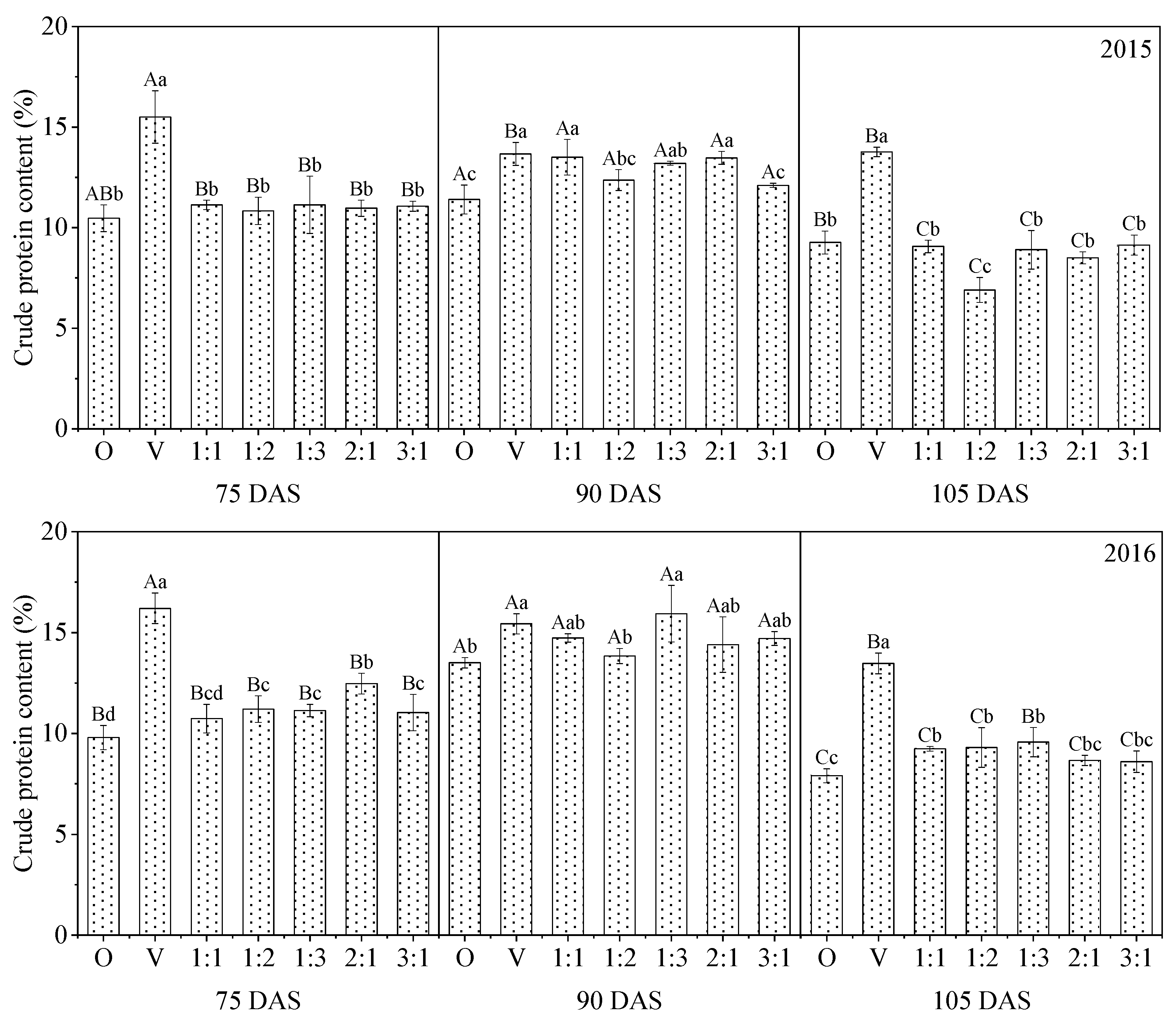
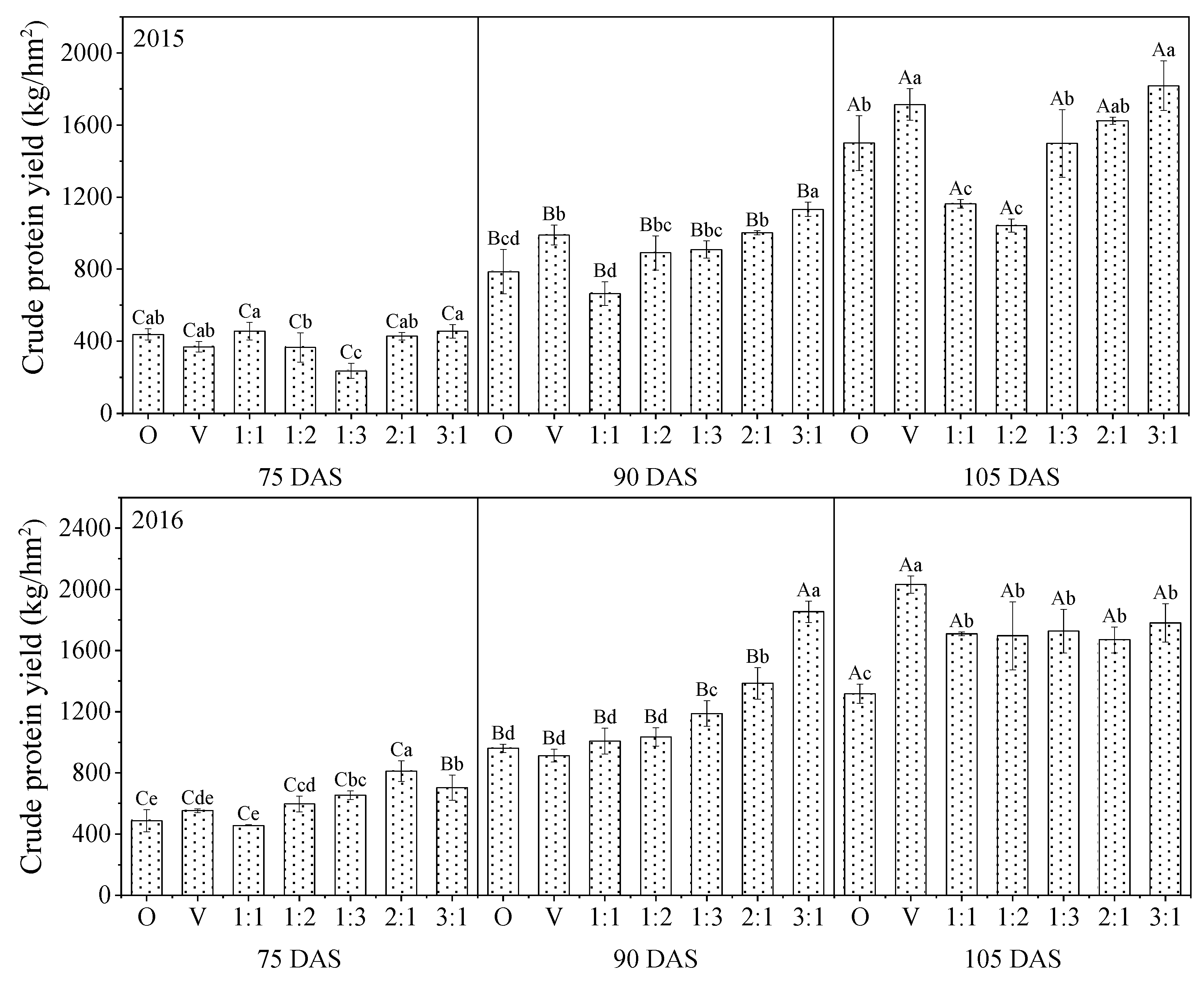
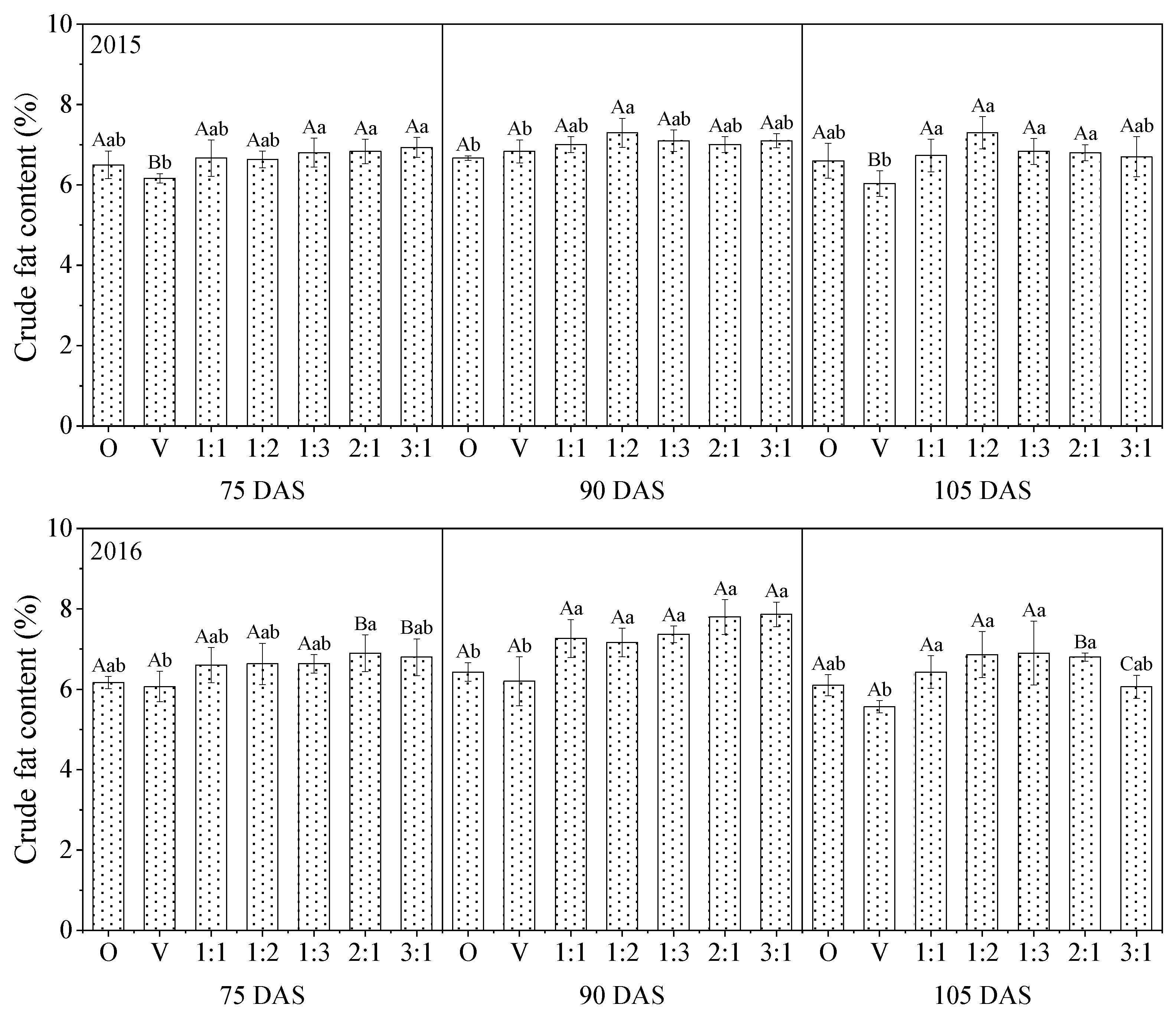
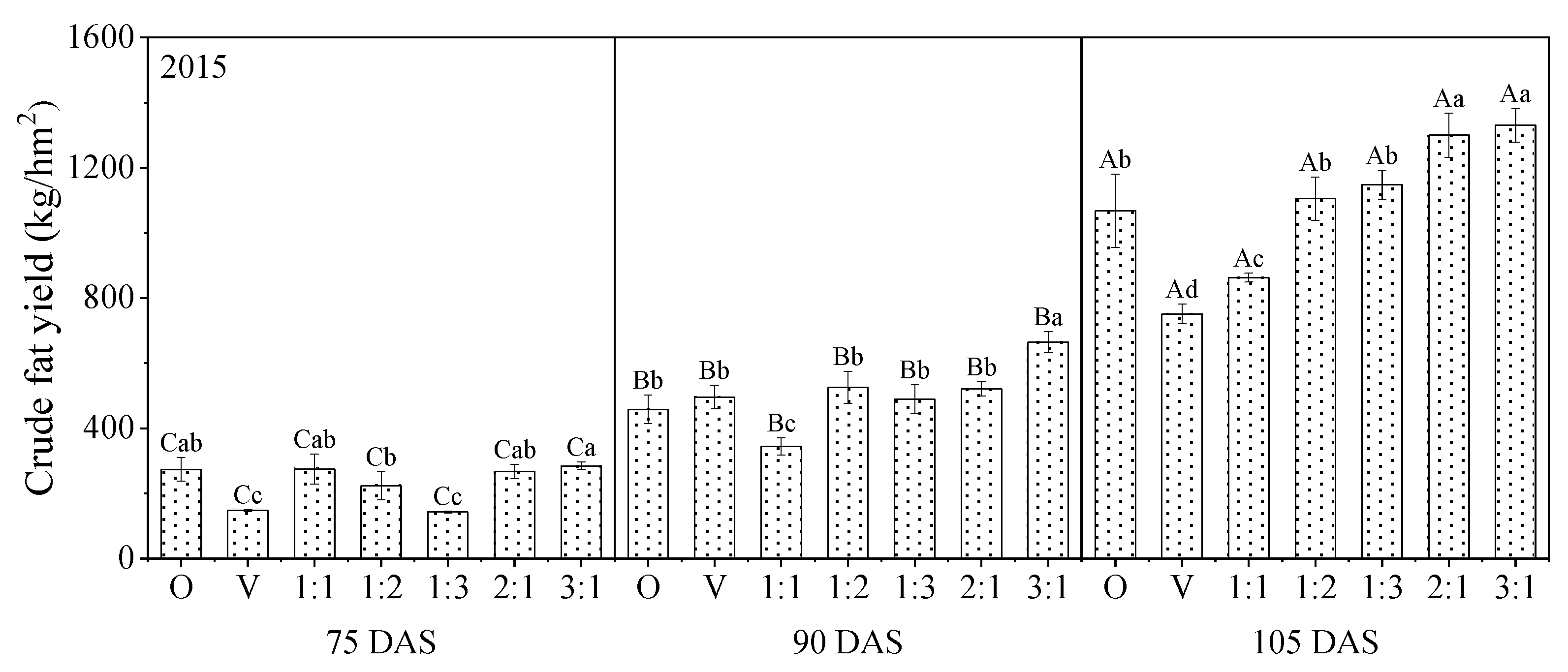

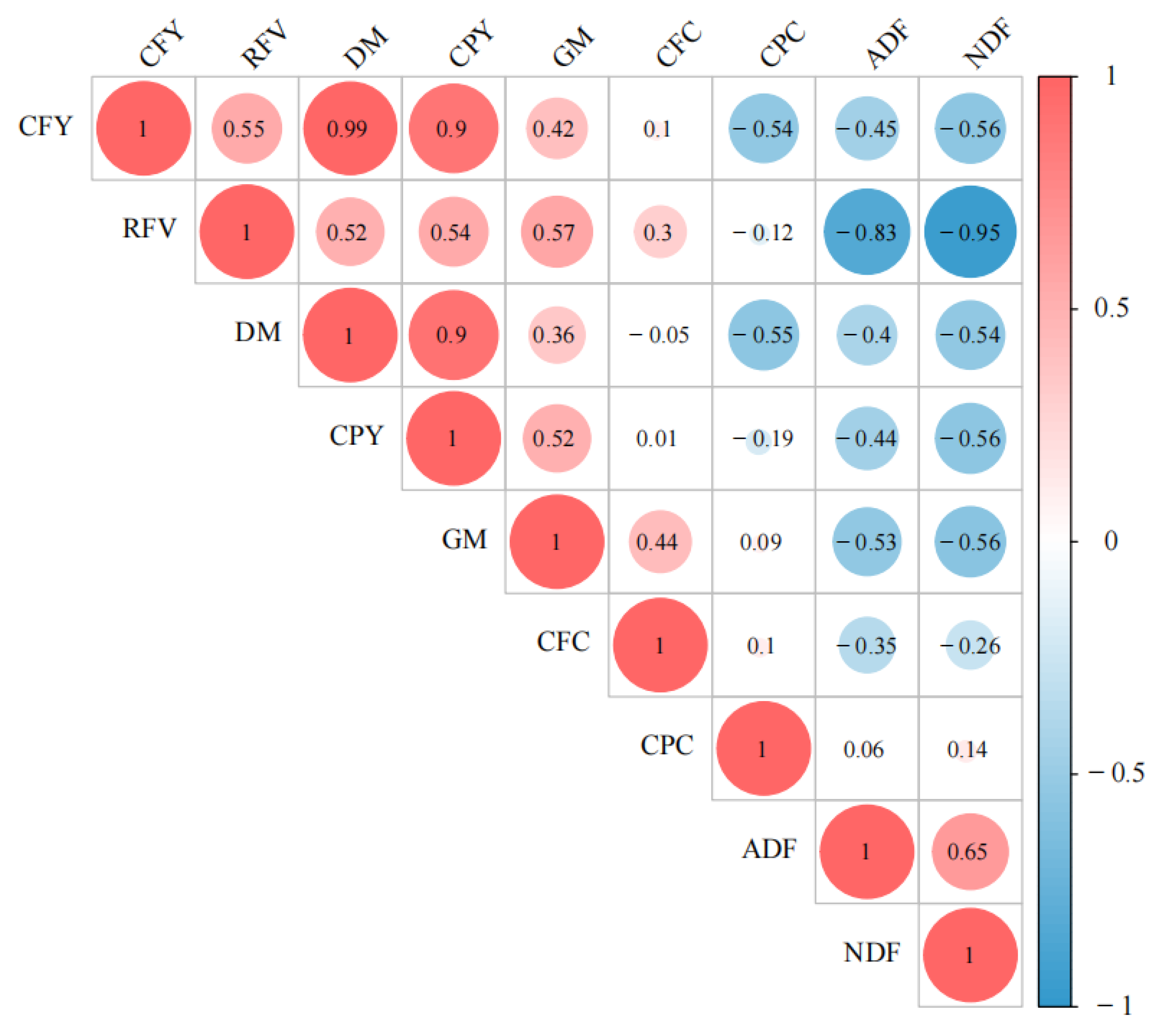
| Climate Factor | Year | Month | |||
|---|---|---|---|---|---|
| 5 | 6 | 7 | 8 | ||
| T max (°C) | 2015 | 23.2 | 25.0 | 28.8 | 28.3 |
| 2016 | 22.5 | 24.8 | 28.1 | 28.1 | |
| T min (°C) | 2015 | 8.6 | 13.4 | 16.7 | 15.3 |
| 2016 | 8.2 | 13.2 | 16.8 | 16.8 | |
| Rainfall a (mm) | 2015 | 5.1 | 19.2 | 20.3 | 9.0 |
| 2016 | 11.5 | 36.0 | 46.4 | 38.3 | |
| Sunshine hours (h d−1) | 2015 | 10.1 | 8.0 | 9.4 | 9.1 |
| 2016 | 9.7 | 8.6 | 8.0 | 8.7 | |
| Treats | Code | Oat Seeding Rate (kg·hm−2) | Common Vetch Seeding Rate (kg·hm−2) |
|---|---|---|---|
| Oat sole | O | 150.0 | ----- |
| Common vetch sole | V | ----- | 60.0 |
| Oat + Common vetch 1:1 | 1:1 | 75.0 | 30.0 |
| Oat + Common vetch 1:2 | 1:2 | 50.0 | 40.0 |
| Oat + Common vetch 1:3 | 1:3 | 37.5 | 45.0 |
| Oat + Common vetch 2:1 | 2:1 | 100.0 | 20.0 |
| Oat + Common vetch 3:1 | 3:1 | 112.5 | 15.0 |
| 75 DAS | 90 DAS | 105 DAS | ||
|---|---|---|---|---|
| 2015 | O | 24.00 Bb ± 0.63 | 28.12 Acd ± 1.06 | 27.46 Ac ± 1.13 |
| V | 13.11 Bf ± 0.25 | 29.04 Ac ± 1.88 | 28.60 Aabc ± 0.70 | |
| OV1:1 | 22.43 Cc ± 0.75 | 32.99 Ab ± 1.37 | 27.94 Bbc ± 0.91 | |
| OV1:2 | 17.33 Bd ± 0.63 | 25.86 Ade ± 0.24 | 25.10 Ad ± 0.96 | |
| OV1:3 | 15.05 Be ± 1.45 | 23.56 Ae ± 2.49 | 24.11 Ad ± 1.06 | |
| OV2:1 | 29.46 Ba ± 0.38 | 35.22 Aab ± 0.16 | 30.56 Ba ± 1.19 | |
| OV3:1 | 29.98 Ba ± 1.31 | 37.27 Aa ± 0.68 | 29.66 Bab ± 1.4 | |
| 2016 | O | 22.92 Cd ± 1.26 | 34.04 Ac ± 1.96 | 29.87 Bc ± 1.96 |
| V | 18.83 Ce ± 1.18 | 28.69 Ae ± 0.93 | 22.99 Bd ± 1.18 | |
| OV1:1 | 22.58 Cd ± 0.93 | 31.61 Ad ± 0.54 | 28.83 Bc ± 1.16 | |
| OV1:2 | 27.72 Bbc ± 0.33 | 32.79 Acd ± 1.79 | 30.15 ABbc ± 1.63 | |
| OV1:3 | 26.11 Bc ± 1.32 | 34.59 Ac ± 1.13 | 32.43 Aab ± 1.10 | |
| OV2:1 | 28.81 Cb ± 0.56 | 37.32 Ab ± 0.20 | 33.33 Ba ± 1.23 | |
| OV3:1 | 30.73 Ca ± 0.98 | 48.60 Aa ± 1.35 | 33.51 Ba ± 1.16 |
| Factors | Df | GY | DMB | CPC | CPY | CFC | CFY | NDF | ADF | RFV |
|---|---|---|---|---|---|---|---|---|---|---|
| T | 54 | ** | ** | ** | ** | ** | ** | ** | ** | ** |
| D | 18 | ** | ** | ** | ** | ** | ** | ** | ** | ** |
| Y | 9 | ** | ** | ** | ** | NS | ** | NS | NS | * |
| T × Y | 54 | ** | ** | NS | ** | NS | ** | NS | NS | * |
| D × Y | 18 | ** | ** | ** | NS | * | NS | NS | NS | NS |
| T × D | 108 | ** | ** | ** | ** | NS | ** | NS | NS | NS |
| T × D × Y | 108 | ** | ** | ** | NS | NS | NS | NS | ** | ** |
| Year | Treatment | 75 DAS | 90 DAS | 105 DAS |
|---|---|---|---|---|
| 2015 | O | 4.19 Ca ± 0.33 | 6.87 Bb ± 0.69 | 16.16 Abc ± 0.68 |
| V | 2.38 Cc ± 0.01 | 7.26 Bb ± 0.69 | 12.46 Ad ± 0.81 | |
| OV1:1 | 4.10 Ba ± 0.42 | 4.93 Bc ± 0.48 | 12.84 Ad ± 0.68 | |
| OV1:2 | 3.35 Cb ± 0.54 | 7.21 Bb ± 0.83 | 15.17 Ac ± 1.00 | |
| OV1:3 | 2.10 Cc ± 0.15 | 6.88 Bb ± 0.38 | 16.81 Ab ± 0.32 | |
| OV2:1 | 3.90 Cab ± 0.17 | 7.44 Bb ± 0.18 | 19.11 Aa ± 0.44 | |
| OV3:1 | 4.11 Ca ± 0.26 | 9.36 Ba ± 0.33 | 19.91 Aa ± 0.96 | |
| 2016 | O | 4.96 Cc ± 0.48 | 7.12 Bc ± 0.15 | 16.69 Ac ± 0.14 |
| V | 3.42 Ce ± 0.15 | 5.92 Bd ± 0.24 | 15.11 Ad ± 0.98 | |
| OV1:1 | 4.27 Cd ± 0.29 | 6.84 Bc ± 0.59 | 18.51 Ab ± 0.11 | |
| OV1:2 | 5.33 Cbc ± 0.27 | 7.48 Bc ± 0.25 | 18.21 Ab ± 0.62 | |
| OV1:3 | 5.89 Cab ± 0.42 | 7.48 Bc ± 0.55 | 18.06 Ab ± 0.71 | |
| OV2:1 | 6.51 Ca ± 0.45 | 9.64 Bb ± 0.64 | 19.27 Ab ± 0.70 | |
| OV3:1 | 6.37 Ca ± 0.25 | 12.61 Ba ± 0.18 | 20.71 Aa ± 0.90 |
| Year | Treatment | 75 DAS | 90 DAS | 105 DAS | ||||||
|---|---|---|---|---|---|---|---|---|---|---|
| NDF | ADF | RFV | NDF | ADF | RFV | NDF | ADF | RFV | ||
| 2015 | O | 66.00 Aa ± 2.00 | 40.00 Aab ± 2.00 | 81.39 Bc ± 0.27 | 54.67 Ba ± 3.06 | 32.00 Bab ± 2.00 | 109.14 Abc ± 7.87 | 52.67 Ba ± 1.15 | 32.67 ABab ± 5.77 | 112.17 Abc ± 9.43 |
| V | 65.33 Aab ± 1.15 | 41.33 Aa ± 3.06 | 80.74 Bc ± 3.39 | 55.33 Ba ± 2.31 | 35.33 Aa ± 6.43 | 103.38 Ac ± 10.78 | 58.00 Ba ± 2.00 | 34.00 Aa ± 3.46 | 100.18 Ac ± 5.65 | |
| OV1:1 | 62.00 Aab ± 2.00 | 34.67 Aabc ± 6.11 | 92.88 Bbc ± 6.76 | 51.33 Aa ± 1.15 | 30.67 Aabc ± 1.15 | 117.86 Abc ± 3.78 | 58.67 Aa ± 10.07 | 33.33 Aab ± 4.62 | 101.73 ABc ± 17.46 | |
| OV1:2 | 64.67 Aab ± 7.02 | 35.33 Aabc ± 4.16 | 89.05 Bbc ± 11.85 | 50.00 Bab ± 3.46 | 29.33 ABabc ± 3.06 | 123.3 Abc ± 10.09 | 48.67 Ba ± 3.06 | 28.67 Babc ± 1.15 | 127.52 Aab ± 6.62 | |
| OV1:3 | 60.00 Aabc ± 3.46 | 35.33 Aabc ± 2.31 | 95.26 Bbc ± 2.80 | 49.33 Bab ± 5.03 | 26.67 Abc ± 4.16 | 129.73 Aab ± 19.3 | 53.33 ABa ± 6.11 | 31.33 Aabc ± 6.11 | 113.17 ABbc ± 11.98 | |
| OV2:1 | 58.67 Abc ± 2.31 | 32.00 Abc ± 6.93 | 101.66 Aab ± 11.15 | 48.67 Aab ± 7.02 | 26.00 Abc ± 2.00 | 133.32 Aab ± 22.03 | 50.67 Aa ± 4.62 | 25.33 Abc ± 4.16 | 127.56 Aab ± 11.24 | |
| OV3:1 | 53.33 Ac ± 4.16 | 31.13 Ac ± 4.76 | 113.39 Ba ± 13.16 | 42.67 Ab ± 2.31 | 24.67 ABc ± 2.31 | 152.16 Aa ± 7.27 | 48.00 Aa ± 8.72 | 24.00 Bc ± 2.00 | 138.52 ABa ± 20.37 | |
| 2016 | O | 66.67 Aa ± 3.06 | 38.47 Aa ± 3.32 | 82.24 Bc ± 1.16 | 54.00 Bab ± 2.00 | 30.67 Ba ± 1.15 | 112.09 Abc ± 4.5 | 50.67 Ba ± 1.15 | 32.67 Bab ± 3.06 | 116.6 Aab ± 6.85 |
| V | 66.27 Aa ± 0.46 | 39.33 Aa ± 2.31 | 81.78 Bc ± 2.30 | 56.00 Ba ± 3.46 | 32.00 Ba ± 3.46 | 106.44 Ac ± 5.81 | 55.33 Ba ± 6.43 | 36.00 ABa ± 4.00 | 103.64 Ab ± 17.63 | |
| OV1:1 | 61.33 Abc ± 1.15 | 37.33 Aa ± 2.31 | 90.76 Bab ± 3.89 | 51.33 Bab ± 1.15 | 28.67 Ba ± 1.15 | 120.69 Aab ± 3.84 | 52.00 Ba ± 6.93 | 33.33 ABab ± 4.16 | 114.3 Aab ± 19.43 | |
| OV1:2 | 63.53 Aab ± 0.81 | 38.00 Aa ± 3.46 | 86.81 Bbc ± 3.51 | 54.00 Bab ± 2.00 | 28.67 Ba ± 5.77 | 114.62 Abc ± 4.50 | 50.00 Ca ± 2.00 | 30.67 ABab ± 3.06 | 121.15 Aab ± 8.30 | |
| OV1:3 | 60.00 Abc ± 2.00 | 39.33 Aa ± 2.31 | 90.44 Bab ± 5.56 | 52.67 Bab ± 2.31 | 30.00 Ba ± 2.00 | 115.97 Abc ± 7.78 | 54.67 ABa ± 4.62 | 29.33 Bab ± 4.16 | 112.7 Aab ± 6.85 | |
| OV2:1 | 61.77 Abc ± 3.06 | 36.00 Aa ± 2.00 | 91.80 Bab ± 5.04 | 51.33 Bab ± 4.16 | 27.33 Ba ± 4.62 | 123.12 Aab ± 12.78 | 49.33 Ba ± 4.16 | 28.67 ABb ± 4.16 | 125.81 Aab ± 6.00 | |
| OV3:1 | 59.33 Ac ± 2.31 | 36.67 Aa ± 1.15 | 94.73 Ba ± 4.99 | 49.33 Bb ± 1.15 | 26.00 Ba ± 2.00 | 129.53 Aa ± 5.84 | 46.67 Ba ± 2.31 | 29.33 Bab ± 3.06 | 131.85 Aa ± 7.35 | |
Publisher’s Note: MDPI stays neutral with regard to jurisdictional claims in published maps and institutional affiliations. |
© 2022 by the authors. Licensee MDPI, Basel, Switzerland. This article is an open access article distributed under the terms and conditions of the Creative Commons Attribution (CC BY) license (https://creativecommons.org/licenses/by/4.0/).
Share and Cite
Qu, J.; Li, L.; Bai, J.; Chen, G.; Zhang, Y.; Chang, Q. Influence of Different Proportion Intercropping on Oat and Common Vetch Yields and Nutritional Composition at Different Growth Stages. Agronomy 2022, 12, 1908. https://doi.org/10.3390/agronomy12081908
Qu J, Li L, Bai J, Chen G, Zhang Y, Chang Q. Influence of Different Proportion Intercropping on Oat and Common Vetch Yields and Nutritional Composition at Different Growth Stages. Agronomy. 2022; 12(8):1908. https://doi.org/10.3390/agronomy12081908
Chicago/Turabian StyleQu, Jiahui, Lijun Li, Jianhui Bai, Guangmin Chen, Yanli Zhang, and Qing Chang. 2022. "Influence of Different Proportion Intercropping on Oat and Common Vetch Yields and Nutritional Composition at Different Growth Stages" Agronomy 12, no. 8: 1908. https://doi.org/10.3390/agronomy12081908
APA StyleQu, J., Li, L., Bai, J., Chen, G., Zhang, Y., & Chang, Q. (2022). Influence of Different Proportion Intercropping on Oat and Common Vetch Yields and Nutritional Composition at Different Growth Stages. Agronomy, 12(8), 1908. https://doi.org/10.3390/agronomy12081908





